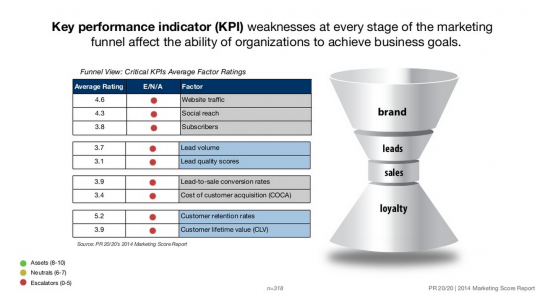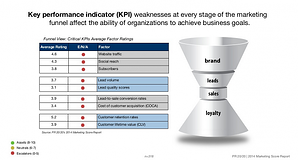This article was originally published on the Marketing Score Blog. We decided to share it here as well because we think you'll find value in it too. Let us know what you think in the comments!
----
The latest in digital technology enables marketers to measure performance across all activities. Yet, it's become a daunting task rather than an opportunity to continually assess and evolve strategies. According to Adobe’s Digital Distress report, 76% of marketers believe measurement is important, yet only 29% believe they are doing it well.
As Paul Roetzer (@paulroetzer) reminds us:
“Measurement matters now more than ever. Marketing technology advances have made it easier and more affordable to connect activities to outcomes, but marketers are largely dropping the ball when it comes to monitoring, reporting, and improving performance.”
Source: Content Marketing Institute, 2013
The 2014 Marketing Score Report shows that marketers rank key performance metrics (KPIs) with low scores across the funnel (below). Could it be that we’re spread thin not only in terms of activities, but also in our focus on the right KPIs?

Slide 32 of The 2014 Marketing Score Report
Enter tunnel-vision, goal-focused marketers. These marketers know they’ll be evaluated against specific sets of prioritized goals, and it’s therefore easier for them to prioritize projects or say “no” to those activities that fall outside scope. In an industry where time is your most valuable asset, marketers who have clearly defined goals and executive-level support will thrive.
It’s time for marketing teams and management to come together to agree on overarching marketing goals—and the KPIs that will track progress toward achieving them. Smart objectives enable marketers to tie activities to KPIs, report on gaps in perceptions and performance, flag opportunities or challenges, and adjust strategies as needed in real time.
Step 1: Define Your Organization’s Marketing Goals
Marketing Score asks internal stakeholders (marketers, executives and entrepreneurs) to prioritize four overarching marketing goals:
- Build brand.
- Generate leads.
- Convert leads into sales.
- Increase customer loyalty.
This question alone can be your most important conversation point when comparing stakeholder assessments across your organization. Remember that marketing goals must tie directly to business goals to be effective.
Once goals are aligned and prioritized, evaluate remaining survey responses to look for gaps in perception and performance. For example, if your executive team agrees that generating leads is your highest priority, yet overall rankings from the Lead Sources assessment (Section 5) are weak, you know up front that the marketing team has a lot of building to do. Each of the 130+ factors throughout the Marketing Score assessment ties to these four, overarching goals in a similar way.
Step 2: Establish Primary KPIs
With access to reporting metrics that can track the success of nearly any activity, how do marketers and leadership decide on primary KPIs, or those that matter most to the overall success of a goal?
Of course there is no single answer to cover every marketing program; it’s based on business goals, lifecycle stage, industry, budget, etc. For the example of a startup B2C flash sale retailer. Top KPIs might be owned audiences, website visitors, checkouts, conversion rates, and repeat purchases.
Identify the 5 to 10 most important metrics to track overall marketing performance. These metrics, or prime KPIs, should align with the four overarching goals covered above. Clearly defined KPIs tied to goals, presented up front for buy-in from all relevant stakeholders, can propel strategy and standardize executive-level performance reports.
From here, marketers can strategize specific campaigns with objectives aimed to improve KPIs, and therefore move the needle against overarching marketing goals.
Step 3: Map Primary KPIs and Supporting Metrics to Your Full-Funnel Scorecard
While no one size fits all, consider the following primary KPIs and supporting metrics to gauge performance throughout the marketing funnel.
Build Brand.
Primary KPI: Website Visitors
Supporting Metrics:
- Inbound links
- Referral visits
- Media mentions
- Owned reach (subscribers, social followers, contact database)
- New visitors
- Returning visitors
Generate Leads.
Primary KPI: Total Leads
Supporting Metrics:
- Gated downloads
- Lead source (advertising, direct, email, calls, social, offline)
- Cost per lead (CPL)
- Lead quality score
- Lead-to-prospect ratio
- Prospects, or sales-qualified leads
Convert Leads Into Sales.
Primary KPI: Customers
Supporting Metrics:
- Conversion rate (visitor to customer; lead to customer; prospect to customer)
- Cost of customer acquisition (COCA)
- New customers
- Revenue won
- Revenue source wins
Increase Customer Loyalty.
Primary KPI: Recurring Revenue
Supporting Metrics:
- Active customers
- Churn rate
- Customer lifetime value (CLV)
- Customer referrals and reviews
- Net promoter score (NPS)
- Engagement (social, web, email, etc.)
- Retention rate
- Revenue (lost, won, per customer, per division, per product)
Step 4: Track Data & Evolve
Consider reporting KPIs with a real-time format, such as an automated Google Drive worksheet. Start with a few months of benchmark data, then continually update and evolve strategy based on prime KPIs and supporting metrics.
Deliver a clean executive report that highlights KPIs, top supporting metrics (no more than 10 for each KPI), and answers the why behind the numbers. For your team, go a step further with a fully annotated report that becomes a daily checkpoint for campaign activities and progress.
Interested in more on marketing performance? Check out a related Marketing Score post for details on marketing performance metrics mentioned specifically above, or the following industry posts:
- Marketing Metrics to Embrace & Ignore, by Justin Gray (@myleadmd)
- How to Build a Scorecard to Measure Content Marketing Effectiveness, by Paul Roetzer (@paulroetzer)
- How to Set SMART Marketing Goals for 2014 [Free Template], by Mike Lemire (@biggestmike)
Share your top 5-10 campaign performance metrics in the comments below. How are you typing KPIs to primary marketing and business goals?

%20Logo_BlueOrange_Trademark.png?width=800&height=269&name=Ready%20North%20(RN)%20Logo_BlueOrange_Trademark.png)




.jpg?width=300&name=Services%20Hub%203%20(3).jpg)



COMMENTS